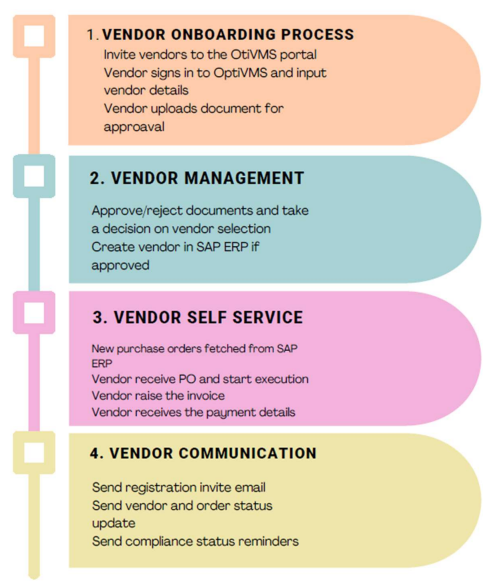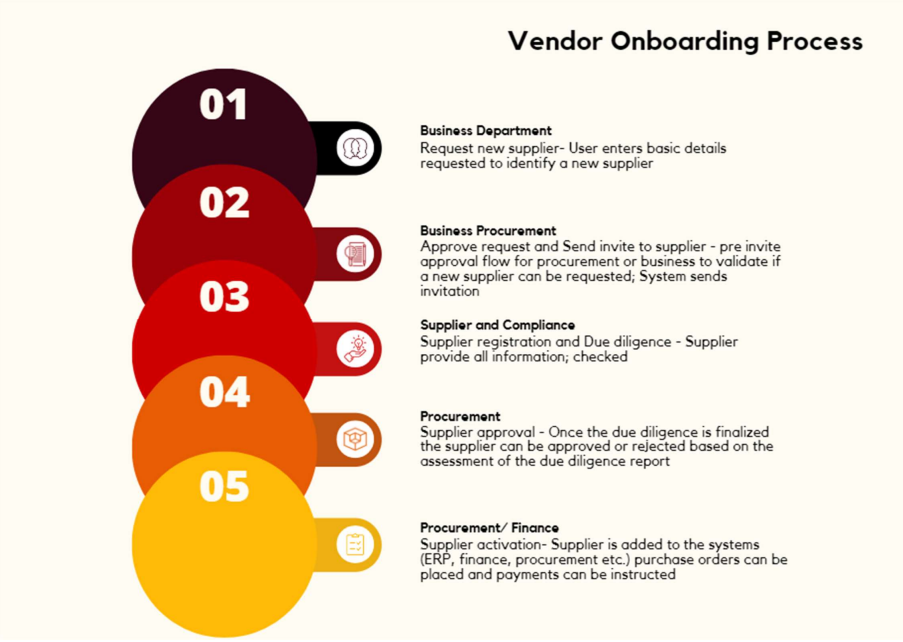Vendor management entails coordinating with vendors to ensure exceptional service delivery to customers. This encompasses onboarding vendors, providing platform training, and fostering collaboration for enhanced profitability for both parties. Additionally, it includes implementing cost control measures, mitigating risks, and enhancing vendor performance.
Vendor Management Process (VMP)

Vendor onboarding is the procedure of gathering necessary information to authorize a company as a supplier, allowing your organization to engage in business transactions, procure goods and services, and facilitate payments to said company. Ensuring compliance with the laws, regulations, and standards mandated by your organization stands as a pivotal component within the vendor
onboarding process.
Phases of Vendor Management
- Discovery, research, and selecting vendors (supplier)
- Organization objectives
- Negotiate contracts
- Vendor onboarding
- Monitoring performance and mitigating risk
- Payment collection and processing\Maintain regular communication, gathering feedback.

Vendor management process: Step by step guide
Why should we have vendor onboarding process?
Vendor onboarding serves as the initial stage in effective vendor management. Without it, optimizing efficiency, mitigating risks, reducing costs, and achieving a higher return on investment become unattainable. Establishing a vendor onboarding process helps sidestep most pitfalls associated with inadequate supplier management.
Just as you nurture relationships with customers, it’s essential to also foster strong connections with your suppliers. Implementing a vendor onboarding process not only strengthens business relationships but also facilitates:
- Mitigate risks
- Streamline processes to increase efficiency
- Ensure compliance with regulations
- Cultivate a positive reputation in the industry
- Increase ROI
- Minimize redundancies
- Track data and workflows effectively
- Automate basic tasks
- Reduce time to approve and activate new suppliers
- Cut out intermediaries and reduce human error
Creating Vendor onboarding process
When initiating an onboarding process within your company, consider the following steps:
- Establishing vendor evaluation and approval processes
- Clarifying requirements and expectations to enhance efficiency and reduce confusion and potential friction
- Creating a vendor registration and data collection platform to expedite vetting processes
- Developing a specialized onboarding process for strategic supplier partnerships, given their substantial impact on your business
- Implementing a robust communication system to enhance efficiency, mitigate the risk of human errors, and foster stronger relationships with suppliers.
Once you’ve outlined the fundamental principles, it’s essential to specify the exact steps, identify responsible departments or individuals, and establish the flow of the onboarding process.
Here is an example of such a process:
The vendor onboarding checklist
To ensure comprehensive coverage, here’s an example checklist you can utilize whenever onboarding a new supplier:
Step1: Evaluate supplier risks:
- Review business product and service track record
- Assess creditworthiness (financial health)
- Evaluate vendor compliance with regulations and governance
- Request vendor to sign an ethical code of conduct
- Develop contingency plans
Step 2: Collect details regarding the products/services offered and commercial terms:
- Anticipated nature, volume, and frequency of requirements
- Lead times
- Additional requirements (e.g., packaging, labels, etc.)
- Order placement procedures and format
- Payment terms
- Delivery logistics
- Procedures for returns and account credits
- Supplier training needs or orientation sessions (if required)
Step 3: Collect vendor information
- Registered name, address, and contact information.
- Licenses, insurance, or relevant documentation
- Banking information.
- Contact information of vendor representatives.
Step 4: Make all information accessible for internal use and share it with
- Accounts department
- Purchasing department
- Warehousing and inventory control team.
Step 5: Share the relevant information with the vendor
- Document all agreed-upon terms and submit for formal approval
- Furnish invoicing particulars
- Supply contact information for purchasing manager, accounts, and warehousing/logistics
- Conduct training and orientation sessions as required



